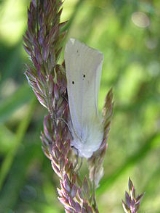
Spilosoma urticae
Encyclopedia
The Water Ermine is a moth
of the family Arctiidae
. It is found in temperate belt of the Palearctic ecozone like similar Spilosoma lubricipedum, but prefer more dry biotopes. So, S. urticae is more abundant in steppes and it is the single Spilosoma species in Central Asia
.
The wingspan
is 38-46 mm. The length of the forewings is 18-22 mm. Hindwings always without black dots. Antennae branches are very short in males, they are equal and not more than twice longer than the antenna stem diameter (this is the best distinguishing character from Spilosoma lubricipedum). The moth flies April to October depending on the location.
The larvae feed on Rumex hydrolapathum
, Mentha aquatica, Iris pseudacorus
, Lysimachia vulgaris
, Jacobaea vulgaris and Pedicularis sylvatica.
Moth
A moth is an insect closely related to the butterfly, both being of the order Lepidoptera. Moths form the majority of this order; there are thought to be 150,000 to 250,000 different species of moth , with thousands of species yet to be described...
of the family Arctiidae
Arctiidae
Arctiidae is a large and diverse family of moths with around 11,000 species found all over the world, including 6,000 neotropical species. This family includes the groups commonly known as tiger moths , which usually have bright colours, footmen , lichen moths and wasp moths...
. It is found in temperate belt of the Palearctic ecozone like similar Spilosoma lubricipedum, but prefer more dry biotopes. So, S. urticae is more abundant in steppes and it is the single Spilosoma species in Central Asia
Central Asia
Central Asia is a core region of the Asian continent from the Caspian Sea in the west, China in the east, Afghanistan in the south, and Russia in the north...
.
The wingspan
Wingspan
The wingspan of an airplane or a bird, is the distance from one wingtip to the other wingtip. For example, the Boeing 777 has a wingspan of about ; and a Wandering Albatross caught in 1965 had a wingspan of , the official record for a living bird.The term wingspan, more technically extent, is...
is 38-46 mm. The length of the forewings is 18-22 mm. Hindwings always without black dots. Antennae branches are very short in males, they are equal and not more than twice longer than the antenna stem diameter (this is the best distinguishing character from Spilosoma lubricipedum). The moth flies April to October depending on the location.
The larvae feed on Rumex hydrolapathum
Rumex hydrolapathum
Rumex hydrolapathum Huds. is a species of perennial herbaceous plants in the genus Rumex native to fens and freshwater banks of Europe and Western Asia...
, Mentha aquatica, Iris pseudacorus
Iris pseudacorus
Iris pseudacorus is a species of Iris, native to Europe, western Asia and northwest Africa. Common names include yellow iris and yellow flag...
, Lysimachia vulgaris
Lysimachia vulgaris
Lysimachia vulgaris is a species of herbaceous perennial plants in the genus Lysimachia native to wetlands, damp meadows and forests of Eurasia. It is a 50-150 cm tall plant with an upright habit, blooming from June through August with erect panicles of conspicuous yellow flowers. L...
, Jacobaea vulgaris and Pedicularis sylvatica.

